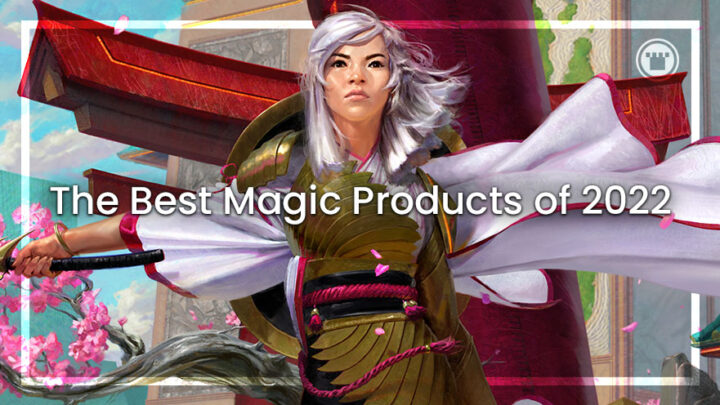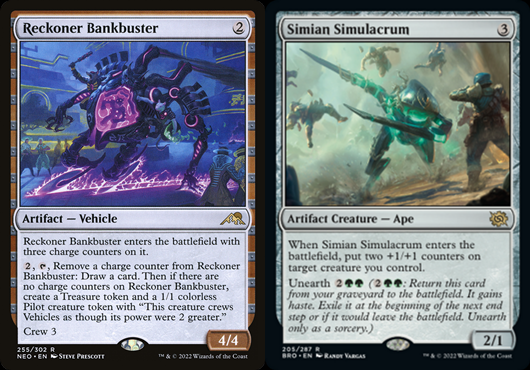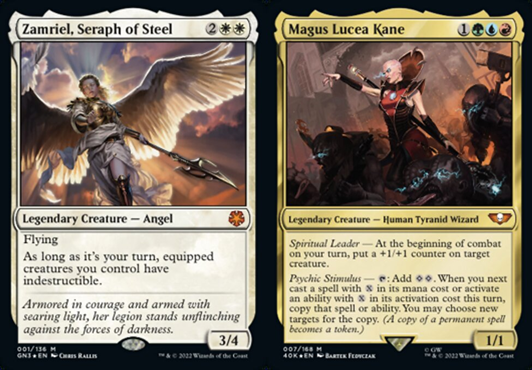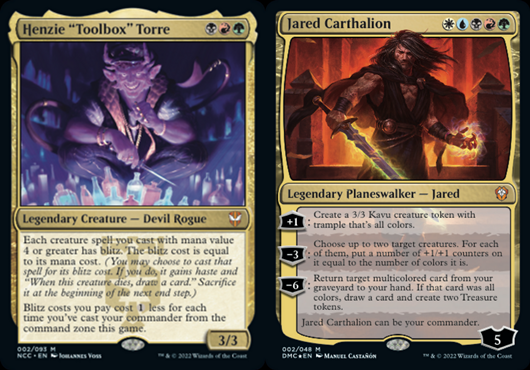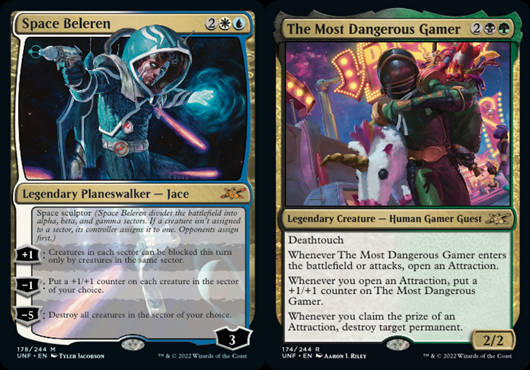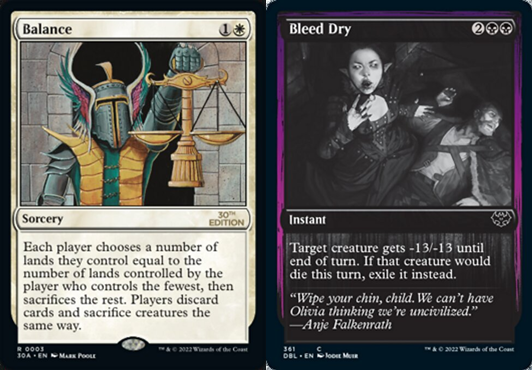December is generally a time for us to take a step back and reflect upon another year of Magic, and we certainly had a packed 2022 to look back on. Despite entering its 30th anniversary celebrations, the game continued to grow faster than it ever has before.
This year saw tons of new cards and new products, which led to overlapping spoiler seasons and some releases getting lost in the crush. Still, with the holidays on the horizon, it’s worth taking stock of every paper Magic release to see how 2022 went overall.
A BUMPER YEAR
Before we go into any detailed evaluation, let’s check the line-up! From most-to-least-recent, here’s the different products you could have walked in to buy at a WPN store:
- Starter Commander Decks
- Jumpstart 2022
- 30th Anniversary Edition
- The Brothers’ War
- The Brothers’ War Commander
- Pioneer Challenger Decks 2022
- Game Night: Free-for-All
- Warhammer 40,000 Commander
- UNFINITY
- Dominaria United
- Dominaria United Commander
- Double Masters 2022
- Commander Legends: Battle for Baldur’s Gate
- Baldur’s Gate Commander Decks
- Starter Set 2022
- Streets of New Capenna
- Streets of New Capenna Commander
- Challenger Decks 2022
- Kamigawa: Neon Dynasty
- Neon Dynasty Commander
- Innistrad: Double Feature
- Commander Collection: Black
STANDARD SETS
It’s been quite the banner year for Magic’s main product line. All four Standard-legal expansions were well received, despite each having a completely distinct creative vision. And while the Standard format itself went through ups and downs early in the year, the metagame since rotation has been another credit to how 2022’s sets were designed and balanced.
I have to hand it to Wizards of the Coat on how well they’ve pulled off “sci-fi” concepts this year. One of the biggest fears in the community around the advent of Universes Beyond was the appearance of guns and other incongruous technology in Magic’s generally low-tech milieu.
However, Standard has now featured cyberpunk (Kamigawa: Neon Dynasty), 1920’s urban noir (Streets of New Capenna) and full-blown giant-robot-industrial-warfare (The Brothers’ War) — and there’s been barely a peep of dissatisfaction on that front. The creative teams behind each set did so well to anchor these cards within their own cool and believable worlds and the wider Magic lore, which gives me a lot of hope for the next few years.
Even looking at the individual cards themselves, I think this year’s Standard sets were definitely among the best products to pick up. Every one contributed a few, new, multi-format staples for Constructed, with Neon Dynasty in particular producing hit after hit.

Commander players and casual fans really reaped the rewards of Set and Collector boosters with a lot of beautiful alt-arts and card treatments, with Neon Dynasty again landing slightly ahead of the pack (those ukiyo-e basics).
I do have to give a thumbs down to the appearance of unique, Commander-legal cards within Standard set boosters, though. It creates needless confusion, and there are already plenty of great Commander cards to chase in these sets without them!
Drafting was one area where 2022’s Standard sets might be a slight step down; albeit from an unsustainable high point. However, that’s some analysis we’ll save for its own future article. In general, these were all excellent sets to buy into, which is always a win for the health of Magic. Well done Wizards!
PRECON DECKS AND BOXED SETS
Preconstructed decks continued to struggle through a crisis of identity and purpose this year, even as Wizards pumped them out like never before. Challenger decks for both Standard and Pioneer, constant Commander decks, various boxed sets with a fixed list of cards… the list goes on.
Are precons meant to be introductory products, aimed at and accessible to a brand-new player? Are they affordable on-ramps to the current metagame of expansive Constructed formats? Are they primarily a distribution system for Wizards to constantly push new cards into the Legacy and Commander metagames? Or are they simply meant to offer the novelty of a curated Magic experience to players at a reasonable price?
Clearly the answer is “all of the above,” but the lines are blurred enough to confuse customer expectations — and sometimes the designers themselves. We saw a major pivot this year where Commander precons became much more functional and focused “out-of-the-box,” rather than attempting to provide a customizable toolkit of interesting cards.
In my own reviews of precons from New Capenna, Baldur’s Gate and Dominaria United, I saw this as a major improvement, since I buy precons to play with or at least upgrade. But I can also see how a deck like the Painbow precon from Dominaria United would feel like a big miss to a player primarily interested in pulling cards out for their existing decks.
Perhaps such dissatisfaction is inevitable after Wizards spoiled us with a hoard of new cards, artwork and reprints in the Warhammer 40,000 Commander decks. They are very likely the most valuable and powerful precons ever made for the format!
The narrower mechanical themes and lower rate of new cards/prized reprints in the “set Commander” decks makes them less exciting for the established player, in a product line which was once the annual purchase for Commander fans. And yet, these precons aren’t necessarily bridging the gap between new Magic players and the complex world of Commander. Why else would Wizards be about to release specific “Starter Commander” precons for the gift-giving season?

Perhaps entry cost is the hidden concern. Wizards have learned to gut such introductory products of any remotely powerful or worthwhile cards so established players don’t drive the price up. Still, by at least making a product only one group of players really wants, Wizards can tailor it to their specific needs. After hours of teaching novice players with Game Night and Starter Set precons at conventions, I can confirm: they do a great job.
SUPPLEMENTAL SETS
I think 2022 has quietly been one of the best years for supplemental sets since the initial wave of Masters products. However, a lot of potential was obscured by how crowded the overall release schedule was, particularly through the first half of the year.
In particular, it seems as though Commander Legends: Battle for Baldur’s Gate may have been much better received had it not been sandwiched between the five Streets of New Capenna Commander precons and Double Masters. It was a fine draft set and had a wealth of fun Commander designs, while successfully paying homage to the beloved video game series. Even while I was still writing about it here at Card Kingdom, many in the community were lamenting how short its time in the sun seemed to be.
But the speed with which we looked past Battle for Baldur’s Gate could be due to the same confusion of purpose which grips Wizard’s precon products. Double Masters was widely perceived as having more desirable Commander cards to open than the so-called “Commander Legends” set. And with the two sets hitting shelves in such a narrow window, they were more or less in competition for the same dollar.
Are the goals of “Commander reprint set” and “Commander Draft set” compatible? Well, Modern Masters and various classic Standard sets prove you can balance the needs of Limited and Constructed with proper design, so there should be hope for Commander Legends, too. I’d actually advocate for an extra Commander set in 2023 and fewer precon releases to better serve the needs of the committed player base.
UNFINITY, meanwhile, took a lot of risks and seemed to get a lukewarm reception; but not, I’d argue, due to the controversial parts. For a set that tried to bring black-border respect to Un-sets, it lacked the design quality and creativity of Unstable.
It almost feels like Wizards wished they could just go back in time and make a bunch of Unstable cards black-border, but instead they applied those lessons to an overall less compelling set. It’s a tough ask, but they needed a really strong sell to convince sceptics that change was worthwhile.
I’ve also heard many casual players complain that making these cards black-border actually makes them less appealing as an Un-set — despite the whole experiment being justified by Wizards saying it would do the opposite. Apparently, having to take these cards “seriously” ruins the atmosphere.
Again, if Wizards is going to release 100 products in a year, maybe they don’t need to please every audience segment. Let casual players buy Un-sets for Un-sets’ sake. At least they took the right approach with the 30th Anniversary Edition — a product that will be excitedly bought by one specific group of people, and which seems pointless to everyone else.
SECRET LAIRS
Wizards continued their blossoming love affair with time-limited drops, offering a dizzying array of Secret Lairs during the last 12 months. And aside from the fundamental ethical concerns around that sales model (fostering and exploiting FOMO, milking the most obsessive collectors in your audience, siphoning off more business from local game stores), I don’t really have any problem with that.
I’ve long held that monetizing the game through exclusive cosmetic upgrades — rather than exclusive game pieces, like Tabernacle — is a more respectable and sustainable approach. If you oppose the impact that card accessibility has on various formats and the idea of pay-to-win Magic, then it’s hard to also rally against Secret Lairs.
There may be individual Lairs I find annoying or ugly, but there’s also standouts like the Junji Ito guest spot, or the too-cute Extra Life cards based on children’s drawings!

The exception to that is when Wizards uses them to introduce exclusive, mechanically unique cards. I love those quirky Street Fighter designs, but limiting them to the Secret Lair sales model obliterates all the arguments I just made in its favor. I really hope we can get some kind of Secret Lair Anthology down the line to make these cards accessible. But when so much of the marketing focuses on exclusivity, it seems unlikely.
At least when we got the mechanically unique Transformers cards later in the year, they were available in Standard set boosters. And the various Warhammer Secret Lair drops avoided printing any mechanically unique cards, despite how freely the associated Commander precons had done so. This seems like a solid compromise, and one I hope Wizards sticks to in 2023.
CONCLUSION
We’ve experienced another year of intense change and growth for Magic, and when you try as many new things as Wizards has, there’s going to be inconsistent results. Still, there were still plenty of well-received, high value products on offer across the year.
The Warhammer 40,000 and Streets of New Capenna precons are probably the best ever for playing out of the box. Kamigawa: Neon Dynasty was an all-time great draft format, and the other Standard sets weren’t far behind.
Double Masters 2022 felt exciting enough to revive the more-or-less-dead idea of Masters sets all by itself! And I’ve just written several articles about my extremely positive forecast for JumpStart 2022.
I don’t think the issue is a lack of great Magic products — it’s that you had to look for them in between less-great ones.
Regardless of whether you agree with my feelings or not, this many releases just dilutes the impact of any individual set or printing. I do think a lot of these products have sound ideas behind them. And with the diverse ways people now play Magic, it makes sense to diversify your releases. Yet there’s a limit to how much of that can be healthy.
Wizards has often reminded players that “not every product is for you” in this kind of expanded release schedule. But their actual product design says the opposite; several sets and precons this year visibly suffered due to attempted appeals to too many distinct demographics within Magic. If 2023 sees no change other than more confident, purpose-driven product design, I predict it will be a huge success.

Tom’s fate was sealed in 7th grade when his friend lent him a pile of commons to play Magic. He quickly picked up Boros and Orzhov decks in Ravnica block and has remained a staunch white magician ever since. A fan of all Constructed formats, he enjoys studying the history of the tournament meta. He specializes in midrange decks, especially Death & Taxes and Martyr Proc. One day, he swears he will win an MCQ with Evershrike. Ask him how at @AWanderingBard, or watch him stream Magic at twitch.tv/TheWanderingBard.

